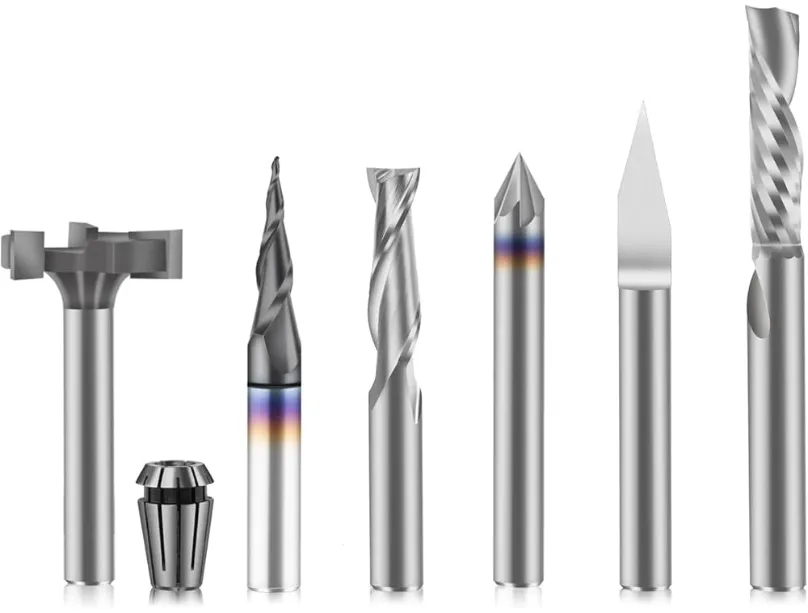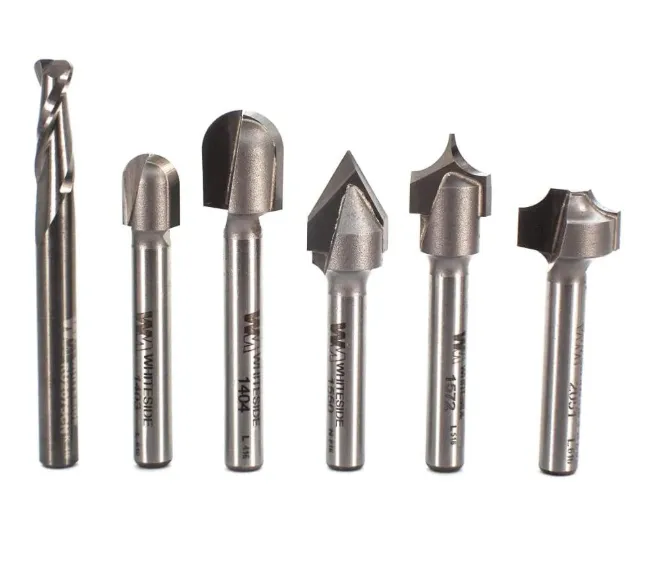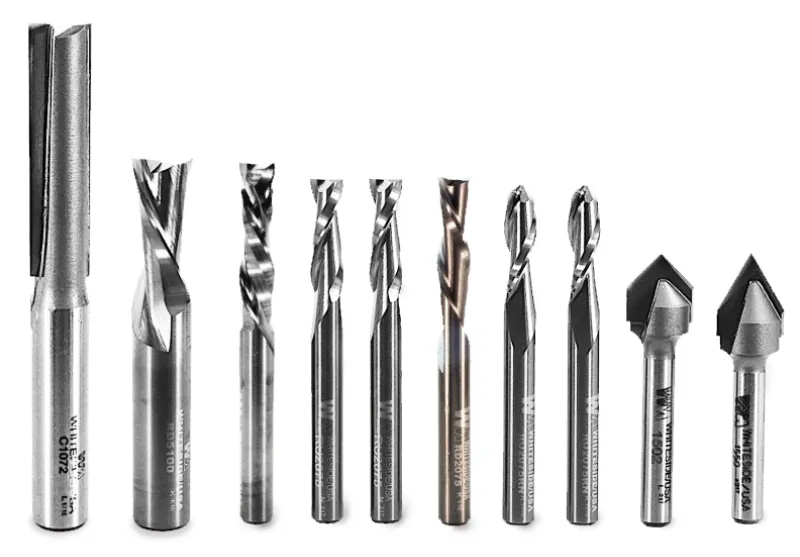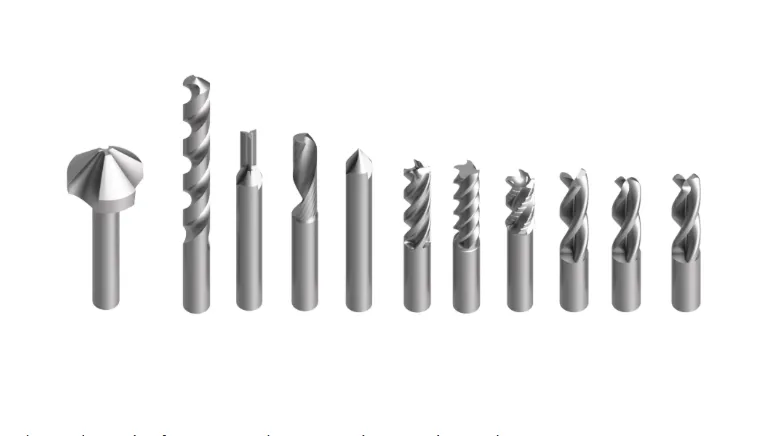Material Composition and Cutting Geometry
CNC router bits are precision cutting tools manufactured from various grades of carbide, high-speed steel (HSS), and occasionally polycrystalline diamond (PCD) for specialized applications. The carbide varieties typically use micro-grain tungsten carbide substrates with cobalt binders, offering superior wear resistance compared to HSS alternatives. Cutting geometries vary dramatically based on application – straight flute bits maintain sharp cutting edges for plastics and laminates, while spiral designs (up-cut, down-cut, and compression) optimize chip evacuation in wood and composite materials. The helix angle (typically 15-45 degrees) significantly influences cutting performance, with steeper angles providing more aggressive material removal in softer materials. Flute count (ranging from single to multiple flutes) affects both finish quality and cutting speed, where fewer flutes allow deeper chip clearance in gummy materials while more flutes produce smoother finishes in hardwoods and metals.
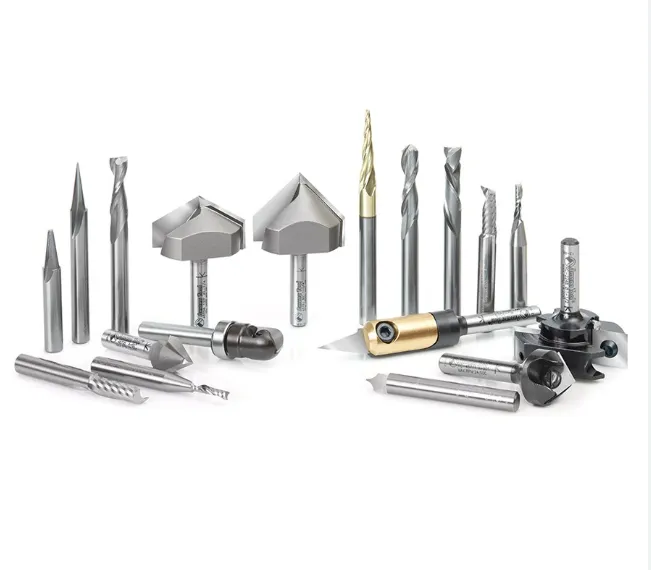 Specialized Bit Types and Applications
Specialized Bit Types and Applications
The router bit market offers hundreds of specialized profiles designed for specific machining operations. Straight bits (1/4″ to 1-1/2″ diameters) handle basic profiling and dado cutting, while rabbeting bits with interchangeable bearings create precise stepped edges. V-groove cutters (30-120 degree included angles) produce decorative chamfers and sign-making features. Panel processing requires specialized bits like the 3-wing composite trimmer that cleanly cuts through laminated materials without chipping. For 3D contouring, ball nose bits (0.5mm to 25mm radius) create smooth organic shapes, particularly in mold making. Specialty bits include T-slot cutters for joinery, dovetail bits for drawer construction, and bowl-cutting bits with large diameters for turning operations. Each profile requires specific feed/speed parameters – for instance, a 1/2″ diameter compression spiral bit in hardwood typically runs at 18,000 RPM with 400-600 IPM feed rates.
Coating Technologies and Surface Treatments
Advanced coating technologies dramatically enhance router bit performance and longevity. Titanium aluminum nitride (TiAlN) coatings withstand temperatures up to 800°C, ideal for metal cutting applications. Diamond-like carbon (DLC) coatings reduce friction when machining abrasive composites. Uncoated polished carbide bits remain standard for wood applications, while aluminum-specific bits often feature zirconium nitride (ZrN) coatings to prevent material adhesion. Surface treatments like cryogenic processing stabilize the carbide microstructure, reducing microfractures that lead to premature failure. Some premium bits incorporate nano-crystalline diamond coatings for machining highly abrasive materials like carbon fiber reinforced polymers (CFRP), extending tool life by 5-10 times compared to uncoated alternatives.
Shank Specifications and Tool Holding
Router bit shanks come in three primary diameters (1/4″, 1/2″, and 3/8″) with metric equivalents (6mm, 12mm). The shank-to-cutting diameter ratio is critical for vibration control – general guidelines recommend at least 1:1 ratio for stability. High-precision collet systems (ER11, ER20, ER25) provide concentricity within 0.005mm TIR when properly maintained. Thermal expansion tool holders use induction heating to secure bits with exceptional grip strength, virtually eliminating slippage during heavy cuts. Anti-vibration tool holders with harmonic damping are particularly effective for long-reach bits (over 4″ cutting length), reducing chatter that degrades surface finish. Some industrial routers utilize HSK tooling systems for automatic tool changes, requiring specially designed router bits with precise dimensional tolerances.
Cutting Parameters and Performance Optimization
Optimal router bit performance requires balancing multiple variables. Chip load (the amount of material removed per tooth) must be maintained within manufacturer specifications – typically 0.1-0.3mm per tooth for wood, 0.05-0.15mm for aluminum. Depth of cut should not exceed 1-1.5 times the bit diameter for most materials. Feed rate calculations consider the formula: Feed Rate (mm/min) = RPM × Number of Flutes × Chip Load. For example, a 2-flute 6mm bit running at 24,000 RPM with 0.1mm chip load requires 4,800mm/min feed rate. Modern CNC controllers can dynamically adjust feed rates based on spindle load monitoring, preventing tool overload in dense material sections. Air blast systems maintain optimal cutting temperatures, particularly important when machining plastics and non-ferrous metals where heat buildup causes material deformation.
Maintenance and Operational Best Practices
Proper router bit maintenance significantly extends tool life and maintains cutting quality. Regular cleaning with specialized bit cleaning solutions removes pitch and resin buildup that causes overheating. Visual inspection under magnification should check for microscopic chips along cutting edges – even minor damage can dramatically reduce cut quality. Sharpening requires diamond grinding wheels with precise angle maintenance – most carbide bits can be resharpened 3-5 times before replacement. Storage in anti-corrosion cases with foam inserts prevents accidental damage to cutting edges. Operational practices like ramp-in entries and trochoidal milling paths reduce sudden load impacts that fracture carbide. Proper collet maintenance, including regular cleaning and replacement of worn components, ensures maximum grip force and minimizes runout that degrades cut quality.
Safety Considerations and Failure Modes
Router bits present significant safety hazards requiring strict protocols. Rotational speeds exceeding 24,000 RPM can propel broken fragments at dangerous velocities if catastrophic failure occurs. Proper machine guarding and personal protective equipment (face shields, hearing protection) are mandatory. Common failure modes include edge chipping from hard inclusions in materials, thermal cracking from inadequate cooling, and catastrophic breakage from excessive feed rates. Vibration analysis systems can detect impending tool failure by monitoring harmonic patterns. Bit deflection becomes problematic with long-reach tools – deflection calculators help determine maximum safe overhang based on material being cut and cutting forces generated. Emergency stop systems must be immediately accessible, and two-hand operation controls prevent accidental contact during bit changes.
Emerging Technologies and Future Developments
The router bit industry continues advancing with several promising technologies. Smart bits with embedded sensors monitor temperature, vibration, and cutting forces in real-time, transmitting data via RFID or Bluetooth. Self-sharpening bits using micro-abrasive coatings that wear selectively maintain sharp edges longer. Bit designs optimized for specific CNC router characteristics (spindle power, rigidity) are becoming more common. Hybrid bits combining drilling and milling functionality reduce tool change requirements. Nano-structured carbide substrates promise 2-3x longer tool life in abrasive materials. The development of universal quick-change systems allows faster bit swaps without sacrificing concentricity. As CNC routers take on more metal cutting applications, we’re seeing increased crossover with traditional milling tool geometries adapted for router spindles. These innovations continue pushing the boundaries of what’s possible with CNC routing across materials from soft foams to aerospace alloys.


